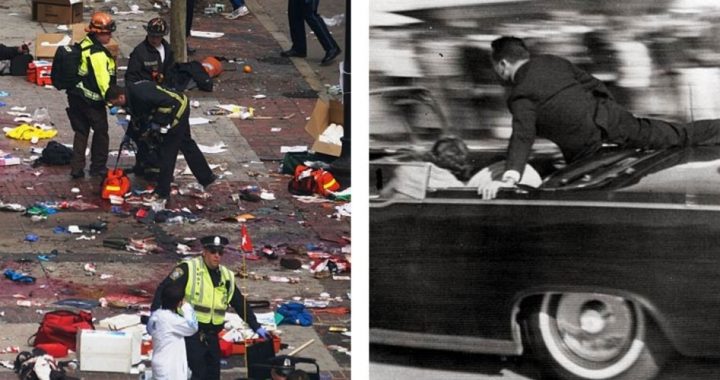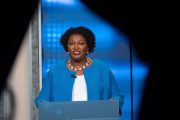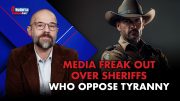
Two very different manhunts occurred in this nation 50 years apart. One was in 1963 in response to the assassination of a president of the United States (image shown on right); the other followed a pair of bomb explosions that killed three people and injured an estimated 264 others at the 2013 Boston Marathon (image shown on left). Viewed together, these two manhunts illustrate how much law enforcement has strayed from its strong constitutional principles and moved toward a police state in the last 50 years.
Assassination of President John F. Kennedy
President Kennedy was shot at approximately 12:30 p.m. on November 22, 1963. The Dallas police, aided by the FBI and Secret Service, immediately initiated a manhunt. The police began seeking information from witnesses in the vicinity, which focused their attention on the Texas School Book Depository building.
According to the Warren Commission Report:
Several eyewitnesses in front of the building reported they saw a rifle being fired from the southeast corner window on the sixth floor of the Texas School Book Depository. One eyewitness, Howard L. Brennan, had been watching the parade from a point on Elm Street directly opposite and facing the building. He promptly told a policeman that he had seen a slender man, about 5 feet 10 inches, in his early thirties, take deliberate aim from the sixth-floor corner window and fire a rifle in the direction of the President’s car.
The report went on to say:
When the shots were fired, a Dallas motorcycle patrolman, Marrion L. Baker, was riding in the motorcade at a point several cars behind the President. He had turned right from Main Street onto Houston Street and was about 200 feet south of Elm Street when he heard a shot. Baker, having recently returned from a week of deer hunting, was certain the shot came from a high-powered rifle. He looked up and saw pigeons scattering in the air from their perches on the Texas School Book Depository Building.
The police had no need to obtain a search warrant because they were in hot pursuit involving a crime that had just occurred and some of the police officers were witnesses to the details. Officer Baker parked his motorcycle and ran into the building. Baker, accompanied by building manager Roy Truly, looked for suspects. They encountered Lee Harvey Oswald in the vicinity of the lunchroom on the second floor. Truly identified Oswald to Baker as an employee who worked in the building. Oswald did not show any outward appearances that would make him a suspect. He was not out of breath, nor was he showing any signs of anxiety. Oswald walked calmly out the building about a minute later.
Shortly after that Dallas police officer W. E. Barnett posted himself at the front door of the building. Oswald didn’t return after lunch. His absence was noticed about 1:00 p.m., and Oswald was now a suspect. Police were notified to be on the lookout for a man matching Oswald’s description. Within minutes the public was notified via radio and television.
About 1:15 p.m. Dallas police officer J. D. Tippit saw a man matching Oswald’s description. As Tippit got out of his car and approached the man, the man opened fire, killing Tippit instantly. Numerous witnesses were in the vicinity, including Domingo Benavedes, who used Tippit’s car radio to report the killing to the Dallas police. Taxi driver William Scoggins and used car lot manager Ted Calloway, acting as concerned citizens, bravely attempted to chase the suspect in Scoggins’ taxi, Calloway having armed himself by picking up Tippit’s gun. They were unsuccessful in catching the suspect, but may have contributed greatly to the eventual arrest by hindering the suspect’s ability to walk calmly.
Shoe store manager Johnny Brewer, who had heard on the radio of the assassination of the president and the killing of the police officer, noticed a man acting suspiciously in front of his store. Brewer followed him a short distance to the Texas Theater, where the suspect ducked into the outer lobby. Mrs. Julia Postal, who worked in the box office selling tickets, also noticed the suspect enter the lobby. Brewer and Postal discussed what they saw. Postal noted that the suspect didn’t buy a ticket. Unable to find him, they assumed correctly that he must have slipped into the theater. Postal called the police.
Seven police officers entered the theater with Brewer. Brewer stepped on the stage with at least one of the police officers. The movie continued as the projectionist gradually raised the house lights under the direction of detective Paul Bentley. Brewer quickly spotted Oswald sitting by himself and pointed him out to police. Oswald, when being searched, drew a gun and attempted to shoot, but patrolman M. N. McDonald overpowered Oswald, and detective Bob K. Carroll seized the gun.
A crowd was gathering outside the theater. Chants of “Kill him! Kill him!” were heard as the seven police officers emerged with Oswald in custody about 1:50 p.m. The manhunt was over in about an hour and 20 minutes. Oswald had fired on police officer J. D. Tippit and attempted to fire on the seven police officers who captured him in the theater. The police didn’t fire a shot.
Boston Marathon Bombings of 2013
On Monday, April 15, 2013, two bombs exploded about 13 seconds apart near the finish line of the Boston Marathon shortly before 3:00 p.m. Local police, state police, and federal law enforcement immediately began a manhunt.
On April 17 CNN online reported that authorities had “pinpointed two men as ‘possible suspects’ who were seen in images near the finish line of this week’s Boston Marathon — moments before twin bombs there exploded.” The CNN report went on to say that “authorities had not yet identified the two men by name” and that “the photographs were not being released to the public for fear of impeding the investigation.” This is a major difference from the JFK assassin manhunt, where the suspect’s description was disseminated to the public immediately by authorities, asking for the cooperation of law-abiding citizens.
On Thursday, April 18, the two suspects’ names, Tamerlan Tsarnaev and Dzhokhar Tsarnaev, and their photos were released. About 10:30 p.m. that night Massachusetts Institute of Technology Police Officer Sean Collier was on duty near Kendall Square in Cambridge. Two suspects matching the descriptions of the Tsarnaev brothers were filmed on a surveillance camera creeping up on Collier and shooting him. Many observers have marveled at how Massachusetts gun laws do an excellent job of disarming law-abiding citizens, but aren’t nearly as good at disarming criminals.
In the early morning hours of Friday, April 19, the two suspects allegedly hijacked a car and temporarily held the driver hostage. After a police chase, suspect Tamerlan Tsarnaev was killed and Transit police officer Richard H. Donohue was wounded.
Later that morning Massachusetts Governor Deval Patrick issued the followed the statement:
We’re asking people to shelter in place. In other words, to stay indoors with their doors locked and not to open the door for anyone other than a properly identified law enforcement officer.
While the governor’s words sounded polite and benign, at least one YouTube video of how it happened paints a very different story. See video here.
Former Congressman Ron Paul described the aftermath of the bombing as follows:
Forced lockdown of a city. Militarized police riding tanks in the streets. Door-to-door armed searches without warrant. Families thrown out of their homes at gunpoint to be searched without probable cause. Businesses forced to close. Transport shut down.
These were not the scenes from a military coup in a far off banana republic, but rather the scenes just over a week ago in Boston as the United States got a taste of martial law.
Ron Paul was criticized for using the word “tanks” when “armored police vehicles” would have been more correct. What is more important than this technicality is the violation of the constitutional rights of innocent persons. A door-to-door search could have been accomplished without violating anyone’s constitutional rights. Consider the following alternative:
It was not necessary to shut down businesses and public transportation, or to order people to stay at home.
In the door-to-door search for the bombers, it was not necessary to order people out of their homes at gunpoint POW-style. The police could simply have knocked on the doors of the homes, distributed pictures of the suspects, and asked the citizens if they had seen them.
The police could have asked the person who came to the door to step outside while being asked these questions. Such a move would have given the police a chance to quietly tell the resident that if the suspect was inside the house and possibly holding hostages, to signal this to the police. One way to signal this would be by the person touching his chin with two fingers. With the person’s back to the door, someone inside holding a hostage out of sight wouldn’t see the signal.
This kind of door-to-door search would proceed quickly and quietly, and would reinstate the traditional partnership of law-abiding citizens helping the police catch criminals.
The police lifted the shelter-in-place order shortly after 6:00 p.m. Once the law-abiding citizens regained some of their freedoms, they were able to assist the police in finding the suspect. That’s when David Henneberry of Watertown, now free to leave the confines of his house, noticed something wasn’t right with his boat parked in his backyard. When he realized the suspect was probably hiding in his boat, he promptly called the police. According to the timestamp on the police helicopter’s thermal image posted on nydailynews.com, the arrest of Dzhokhar Tsarnaev was in progress at about 7:36 p.m.
The New American’s Thomas Eddlem wrote:
On the evening of April 19, 2013, police investigation revealed that there was an individual in a covered boat located at 67 Franklin Street in Watertown. After a stand-off between the boat’s occupant and the police involving gunfire, the individual was removed from the boat and searched.
While it was technically true that Tsarnaev’s apprehension “involved” gunfire, Tsarnaev was not among those who had fired any of the guns that night. The FBI later admitted that Tsarnaev had been unarmed in the boat. All of the dozens — possibly hundreds — of rounds fired off in the moments before the arrest were by arresting officers or their back-up units, not by Tsarnaev. After that cowboy-like melee, the wounded Tsarnaev was arrested.
Police-state Tactics Were Counter-productive
Another point largely ignored by the liberal news media is that Dzhokhar Tsarnaev was captured just outside the 20-block area of the most intensive part of the search. The noise made by the unconstitutional military-style operation probably aided the suspect in staying hidden from police, because he was able to monitor the police movements just by remaining silent and listening to the commotion. Contrast this to the capture of Lee Harvey Oswald, where the police acted in a low-key manner. Once Oswald lost his calm demeanor, he became an obvious suspect outside the shoe store, and a pair of law-abiding citizens reported him to police. Even though Oswald regained his composure while hiding out in the Texas Theater, it was another example of law-abiding citizens cooperating with police that pointed him out.
The purpose of law enforcement in a constitutional republic is to gather evidence and arrest criminals, not to violate the rights of law-abiding citizens in the name of security. Once the accused person is arrested, he is turned over to the courts for a speedy public trial. That’s where a jury decides if he is guilty, and the public nature of the evidence-based process not only ensures a fair trial for the accused, but also enables the American people to learn how it was done and be aware of any conspiracies operating in the country.
Is there a Russian connection to the Boston Marathon bombing or the JFK assassination? How many undesirables are coming into our country as legal immigrants as well as illegal aliens? A speedy public trial in the Boston Marathon bombing case may lead to answers to these questions.
The American people were robbed of their right to a public trial of Lee Harvey Oswald when he was killed by Jack Ruby two days later while in custody. It is to be hoped that the Boston Marathon bombing trial will take place shortly, not only for the protection of the rights of the accused, but also for the American people’s right to be informed.



